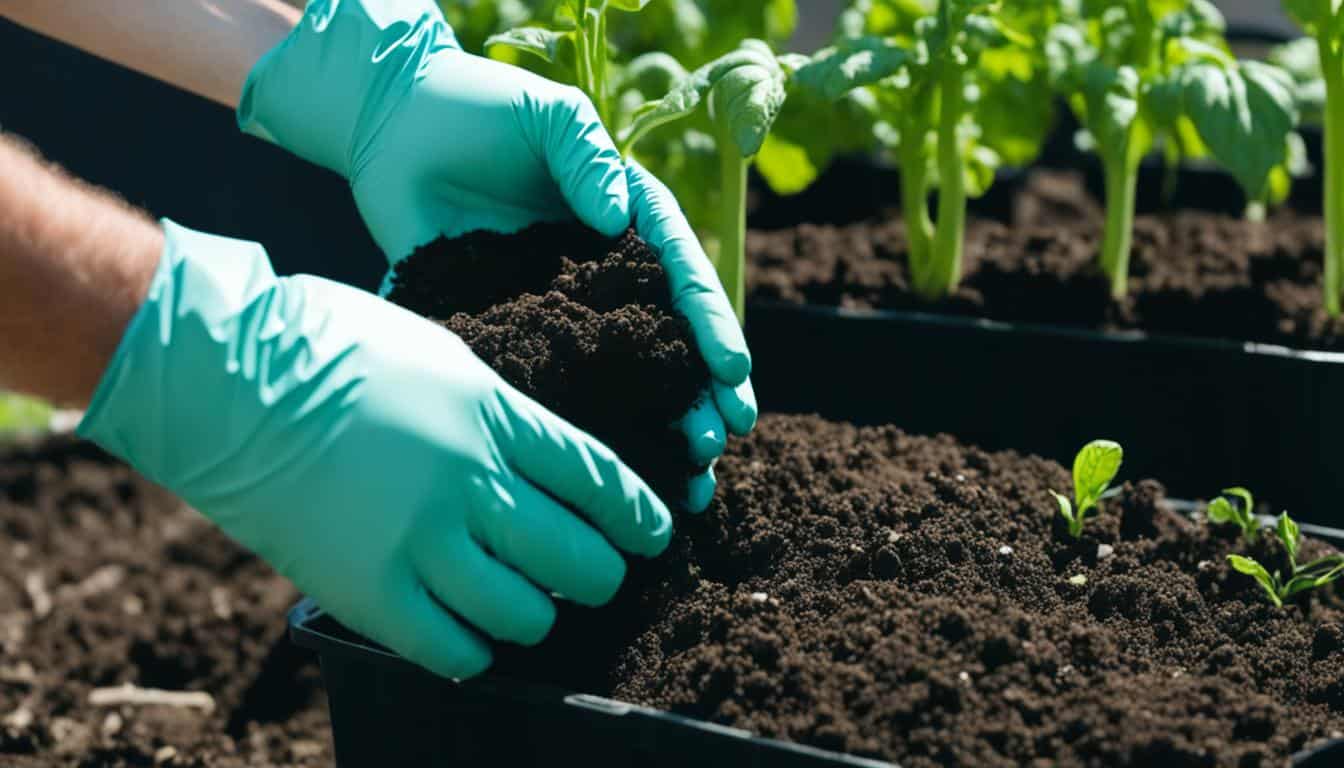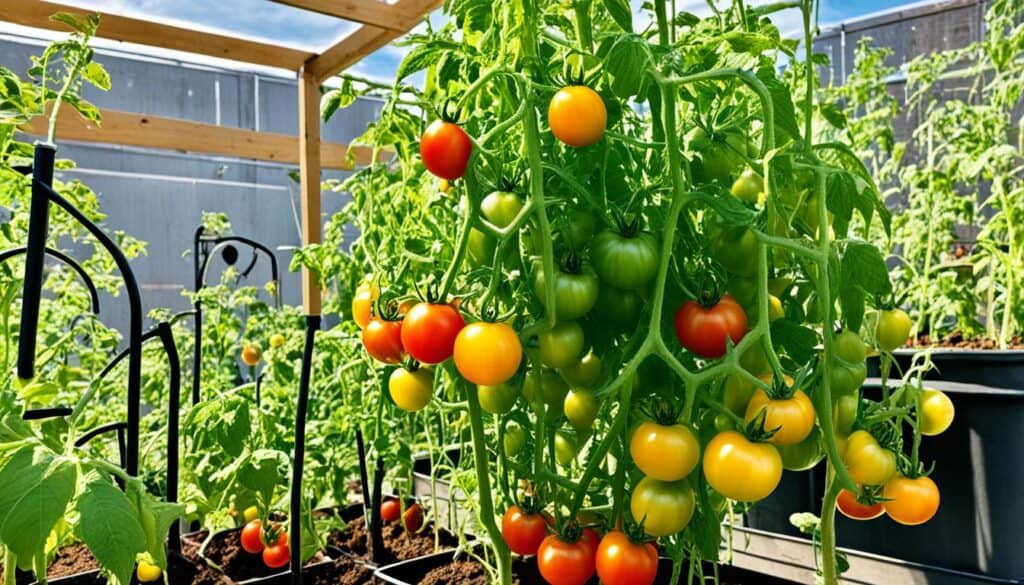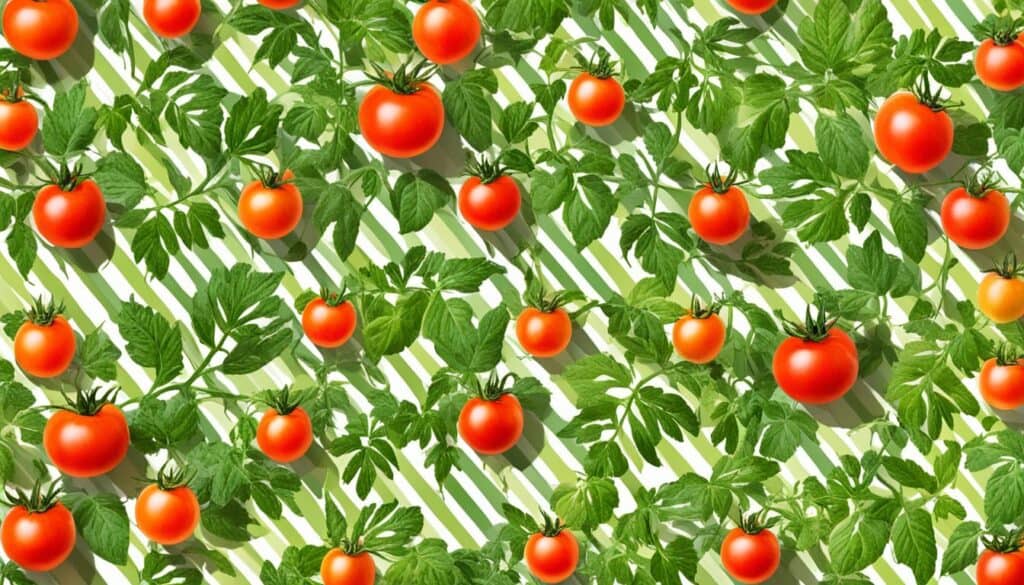When it comes to heirloom tomatoes, the Mr. Stripey variety is making waves with its large, juicy fruit and unique appearance. These tomatoes, known for their irregular yellow and red stripes, are not only visually appealing but also incredibly delicious. Their meaty texture and high sugar content make them perfect for slicing and incorporating into a variety of dishes.
But what does it take to grow these stunning tomatoes in your own garden? In this article, I will share tips and tricks for successfully growing Mr. Stripey tomatoes. From planting to harvesting, I’ll cover everything you need to know to cultivate these flavorful heirlooms in your backyard.
Key Takeaways:
- Mr. Stripey tomatoes are a flavorful variety of heirloom tomatoes known for their large size and unique yellow and red stripes.
- These tomatoes thrive in full sun exposure and well-drained, loamy soil with a slightly acidic pH.
- Proper spacing, support, and pruning techniques are essential for the vigorous growth of Mr. Stripey tomato plants.
- Regular and deep watering, as well as organic fertilization, can promote healthy fruit development.
- Harvest Mr. Stripey tomatoes when they have a deep color, feel firm, and are around 80 to 90 days after transplanting.
Planting Mr. Stripey Tomatoes
When it comes to planting Mr. Stripey tomatoes, timing and soil conditions play a crucial role in ensuring a successful harvest. Here are some key tips to keep in mind:
1. Timing
Plant Mr. Stripey tomatoes when there is no further danger of a late spring frost. The soil temperature should be at least 60 degrees F before transplanting them outdoors. To protect seedlings from shock, it’s essential to harden them off by gradually exposing them to outdoor conditions.
2. Planting Site
Choose a planting site that receives full sun exposure throughout the day. Mr. Stripey tomatoes thrive in well-drained soil, so ensure excellent soil drainage to prevent waterlogging. Avoid planting them in areas where other nightshade family plants, such as peppers, eggplants, or potatoes, were grown in previous years to reduce the risk of disease.
3. Spacing and Support
Mr. Stripey tomatoes are indeterminate, meaning they have a vining growth habit and can reach impressive sizes. To accommodate their vigorous growth, provide at least 3 feet of spacing in each direction between plants. Stake or use tomato cages to support the plants and prevent them from sprawling on the ground.
4. Soil Preparation
Before planting, prepare the soil by incorporating organic matter, such as compost or well-rotted manure, to improve fertility and drainage. Mr. Stripey tomatoes prefer soil with a slightly acidic pH (around 6.0 to 6.8).
5. Watering and Fertilization
Establish a regular watering routine for your tomato plants, providing deep waterings to encourage healthy root development. Avoid overwatering, as it can lead to root rot. Water at the base of the plant to minimize the risk of fungal diseases. Fertilize with slow-release organic fertilizer or tomato-specific fertilizer according to the recommended amounts and timing on the label.
6. Climate Considerations
While Mr. Stripey tomatoes are well-suited for warm climates, they can also be grown in more northern regions. Adequate air circulation and spacing between plants are crucial in preventing the spread of fungal diseases, especially in humid climates.
| Planting Spacing | Soil Temperature | Hardiness Zones |
|---|---|---|
| At least 3 feet in each direction for indeterminate growth | At least 60 degrees F | Varies (typically Zones 3-9) |
Note: Hardiness zones may vary depending on the specific climate conditions in your region. Consult USDA Hardiness Zone maps for accurate information regarding your location.
These guidelines will help you get started with planting Mr. Stripey tomatoes and create an ideal environment for their growth. Stay tuned for the next section, where we’ll dive into the growing conditions and care tips for these unique heirloom tomatoes.
Growing Conditions and Care for Mr. Stripey Tomatoes
Mr. Stripey tomatoes are a delightful addition to any garden, known for their vibrant colors and delicious flavor. To ensure a successful harvest, it’s important to provide the right growing conditions and care for these unique tomatoes.
Growing Conditions
Mr. Stripey tomatoes thrive in warm climates but can also be grown in more northern regions. When choosing a planting site, look for full sun exposure and well-amended soil. Adding organic matter, such as compost or aged manure, will enrich the soil and provide essential nutrients.
| Conditions | Requirements |
|---|---|
| Soil type | Well-amended, loamy soil |
| pH levels | Slightly acidic (6.0 to 6.8) |
| Watering | Regular, deep watering |
| Humidity | Moderate humidity levels |
| Frost tolerance | Not frost-tolerant |
These tomatoes prefer well-drained soil, so avoid heavy or poorly draining soil that can hinder their growth. The pH level of the soil should be slightly acidic, which can be achieved by adding amendments like peat moss or sulfur if necessary.
Caring for Mr. Stripey Tomatoes
Proper watering is crucial for the health of Mr. Stripey tomatoes. Water deeply and consistently, ensuring the soil remains evenly moist. Avoid overwatering as it can lead to rot and other diseases. Water at the base of the plant to prevent fungal diseases from spreading.
To encourage good air circulation and prevent the onset of fungal diseases, provide adequate spacing between plants. Pruning is also essential for indeterminate tomatoes like Mr. Stripey. Remove suckers and long branches to manage growth and increase airflow. Late-season pruning can redirect energy towards ripening remaining tomatoes.
Proper watering is crucial for the health of Mr. Stripey tomatoes. Water deeply and consistently, ensuring the soil remains evenly moist. Avoid overwatering as it can lead to rot and other diseases. Water at the base of the plant to prevent fungal diseases from spreading.
Tomato diseases can pose a threat to the health of your Mr. Stripey plants. Keep an eye out for common issues, such as Late Blight, Blossom End Rot, and bacterial spot. Regularly inspect the plants for any signs of disease and take appropriate measures, such as applying organic fungicides or removing affected leaves or fruit.
Lastly, if you wish to propagate Mr. Stripey tomatoes, save the seeds and store them properly. This allows you to enjoy these delightful tomatoes for future growing seasons.
In conclusion, by providing the right growing conditions, practicing proper care, and being vigilant about disease prevention, you can enjoy a bountiful harvest of delicious Mr. Stripey tomatoes. Experiment with different techniques, such as pruning and container growing, to enhance your gardening experience. Happy growing!
Harvesting and Storing Mr. Stripey Tomatoes
After patiently nurturing your Mr. Stripey tomato plants, it’s time to enjoy the fruits of your labor. Harvesting Mr. Stripey tomatoes at the right time ensures maximum flavor and freshness. Let’s explore how to identify ripe tomatoes and store them for later use.
Identifying Ripe Tomatoes
When it comes to harvesting Mr. Stripey tomatoes, the key is to pick them when they are fully ripe. Ripe tomatoes exhibit specific characteristics that indicate their readiness for harvest. Look for tomatoes with a deep color, typically more yellow near the stem and a rich red underneath. These vibrant colors are a clear sign of ripeness.
Additionally, ripe Mr. Stripey tomatoes should feel firm but not too hard when gently squeezed. Avoid tomatoes that are overly soft, as they may be overripe or even starting to rot. Trust your instincts and use your senses to determine when each tomato is at its peak ripeness.
Remember to harvest your Mr. Stripey tomatoes regularly, as the plants continue to produce fruit throughout the growing season. Removing any affected or damaged fruit immediately can prevent the spread of diseases to the healthy ones.
Storing Tomatoes
If you’re not planning to consume your Mr. Stripey tomatoes right away, proper storage is crucial to maintain their quality. Avoid refrigerating your tomatoes, as it can have a negative impact on their texture and flavor. Instead, store them at room temperature in a cool and dry place.
Consider arranging your tomatoes in a single layer, allowing air to circulate freely around each fruit. This prevents them from becoming squished or bruised. A countertop or pantry shelf works well for short-term storage.
If you have an abundance of ripe tomatoes, you can explore various preservation methods to enjoy them in the future. Canning, freezing, or making tomato-based products like sauces or salsa are excellent ways to extend the shelf life of your Mr. Stripey harvest.
Remember to label and date any preserved tomato products for easy identification.
Now that you know how to harvest and store your Mr. Stripey tomatoes, you can savor their delicious flavor long after the growing season ends. Enjoy the fruits of your labor and explore creative ways to incorporate these sweet and tangy tomatoes into your favorite recipes.
Pruning and Supporting Mr. Stripey Tomato Plants
Pruning is an essential practice for maintaining the health and productivity of indeterminate tomato varieties like Mr. Stripey. By managing growth and improving airflow, pruning helps promote better fruit development and reduces the risk of diseases. Here are some tips for pruning Mr. Stripey tomatoes:
1. Prune in stages
Start pruning when the plants are young by removing suckers and long branches. This helps redirect energy towards the main stem and encourages robust growth. As the season progresses, selectively remove older leaves to improve airflow and prevent disease.
2. Late-season pruning
In the late season, consider pruning to redirect the plant’s energy towards ripening the remaining tomatoes. By focusing nutrients on the fruit, you can enhance their flavor and accelerate the ripening process.
3. Provide proper support
Indeterminate tomatoes like Mr. Stripey require adequate support to prevent them from sprawling and to maintain good air circulation. Consider using stakes, cages, or trellises to support the plants. This helps keep the fruit off the ground and reduces the risk of soil-borne diseases and fruit rot.
4. Spacing matters
Proper spacing between tomato plants is crucial for improving air circulation and reducing the risk of fungal diseases. Allow at least 3 to 4 feet of space between Mr. Stripey plants to ensure they have room to grow and receive sufficient airflow.
Supporting and pruning Mr. Stripey tomato plants helps ensure their growth and productivity while minimizing the risk of diseases. By following these practices, you can enjoy a bountiful harvest of these flavorful, striped tomatoes.
Propagation and Container Growing of Mr. Stripey Tomatoes
When it comes to growing Mr. Stripey tomatoes, there are two key aspects to consider: propagation and container growing. Let’s explore each of these in detail.
Propagating Mr. Stripey Tomatoes
To propagate Mr. Stripey tomatoes, you can save and properly store the seeds from mature fruit. This allows you to have control over the germination process and ensure the quality of the seeds. Starting the seeds indoors is recommended, especially in warm climates with long growing seasons.
Note: Handling seeds with care and providing optimal germination conditions will increase your chances of successful propagation.
Container Growing of Mr. Stripey Tomatoes
While container growing is possible for Mr. Stripey tomatoes, it’s important to note that it’s not the ideal method due to the plant’s size and heavy fruit load. However, if you choose to grow them in containers, follow these guidelines:
- Choose a container with a minimum volume of 5 gallons to accommodate the root system.
- Ensure the container has proper drainage to prevent waterlogging.
- Fill the container with high-quality, nutrient-rich potting soil to provide optimal growing conditions.
- Place the container in a location that receives at least six to eight hours of direct sunlight per day.
- Regularly water the container-grown tomatoes to keep the soil moist but not overly saturated. Check moisture levels frequently, as container-grown plants tend to dry out faster than those in the ground.
- Fertilize the container-grown tomatoes more frequently compared to garden plants. Follow the instructions on tomato-specific fertilizer labels to provide the necessary nutrients.
Note: Container-grown tomatoes may have different water and nutrient needs compared to garden plants. Monitor their growth and adjust your care routine accordingly.
In conclusion, propagating Mr. Stripey tomatoes from saved seeds and container growing are viable options for enthusiasts. Whether you choose to propagate these heirloom tomatoes or grow them in containers, with proper care and attention, you can enjoy a bountiful harvest of these unique and flavorful fruits.
| Propagation | Container Growing |
|---|---|
| – Save and store seeds | – Choose a container with a minimum volume of 5 gallons |
| – Start seeds indoors | – Ensure proper drainage |
| – Fill with high-quality potting soil | |
| – Provide sufficient sunlight | |
| – Regularly water and fertilize |
Common Issues in Growing Mr. Stripey Tomatoes
When growing Mr. Stripey tomatoes, it’s important to be aware of common problems that can arise. These issues can affect the overall health and productivity of your plants, so taking preventive measures and timely action is crucial.
Tomato Diseases
Mr. Stripey tomatoes can be susceptible to various diseases, including late blight, bacterial spot, and fungal diseases. These diseases can cause leaf spots, wilting, stunted growth, and ultimately, a decline in fruit quality and yield. Regularly monitor your plants for any signs of disease and take appropriate measures to prevent their spread.
Blossom End Rot
Blossom end rot is a common problem in tomato plants, including Mr. Stripey tomatoes. It is characterized by sunken brown and leathery patches on the blossom end of the fruit. This condition is often caused by calcium deficiency, uneven watering practices, or imbalances in nutrient levels, particularly nitrogen and magnesium. Ensuring regular and deep watering, providing adequate calcium levels, and maintaining proper nutrient balance can help prevent blossom end rot.
Cracking in Tomatoes
Tomato cracking can occur in Mr. Stripey tomatoes, especially due to irregular watering practices. Cracks usually develop on the top of the fruit and can be both cosmetic and a gateway for pests and diseases. To prevent cracking, maintain a consistent and regular watering routine that provides a steady supply of moisture to the plants.
| Common Issues | Possible Causes | Preventive Measures |
|---|---|---|
| Tomato Diseases | Late blight, bacterial spot, fungal diseases | Regular monitoring, proper sanitation, fungicide application |
| Blossom End Rot | Calcium deficiency, irregular watering, nutrient imbalances | Regular deep watering, adequate calcium levels, balanced nutrients |
| Cracking in Tomatoes | Irregular watering | Consistent and regular watering routine |
By addressing these common issues and implementing preventive measures, you can ensure the health and productivity of your Mr. Stripey tomato plants. Regular monitoring, proper watering practices, and maintaining good overall plant hygiene will go a long way in preventing these problems and enjoying a successful harvest.
Mr. Stripey Tomato Variants and Similarities
When it comes to Mr. Stripey tomatoes, it’s important to note that there are different variants available, each with its own unique characteristics. One notable distinction is between the American Mr. Stripey tomato and the English greenhouse heirloom tomato that share the same name.
The American Mr. Stripey tomato is renowned for its large, meaty, and sweet fruit adorned with eye-catching irregular yellow and red stripes. This variety is a favorite among gardeners for its exceptional flavor and visual appeal.
On the other hand, the English Mr. Stripey greenhouse heirloom tomato also displays stripes on its fruit but differs significantly in taste and growing conditions. This variant possesses its own distinct flavor profile and requires specific environmental conditions to thrive.
So, while both the American and English Mr. Stripey tomatoes share a common name and stripe pattern, they offer unique taste experiences and require different approaches to cultivation. Gardeners interested in exploring the world of Mr. Stripey tomatoes should take these variations into account when selecting seeds or plants for their garden.
Conclusion
Growing Mr. Stripey tomatoes can be a truly delightful experience for any tomato enthusiast. These heirloom tomatoes are not only visually stunning with their vibrant yellow and red stripes but also offer a delectable flavor and a meaty texture that sets them apart from other varieties. By following a few key guidelines, gardeners can ensure a successful harvest of these delicious tomatoes.
First and foremost, it is essential to choose a suitable planting site for Mr. Stripey tomatoes. They thrive in full sun exposure and prefer well-drained, loamy soil with a slightly acidic pH. Adequate support and spacing are also crucial, as these indeterminate plants can grow vigorously and produce heavy fruit loads. Regular watering, avoiding both overwatering and underwatering, is important for maintaining the plants’ health and avoiding common issues like blossom end rot.
Experimenting with different growing techniques, such as pruning and container gardening, can further enhance the gardening experience and optimize yields. Proper pruning helps manage plant growth, enhance airflow, and redirect energy towards ripening tomatoes. While container growing is possible, it is important to select a container with sufficient volume and provide extra care in terms of watering and fertilization.
In conclusion, with the right care and attention, growing Mr. Stripey tomatoes can be a rewarding endeavor. Embrace the uniqueness of these beautiful heirloom tomatoes, and enjoy the rich and succulent flavor they bring to your garden and table.








Leave a Reply